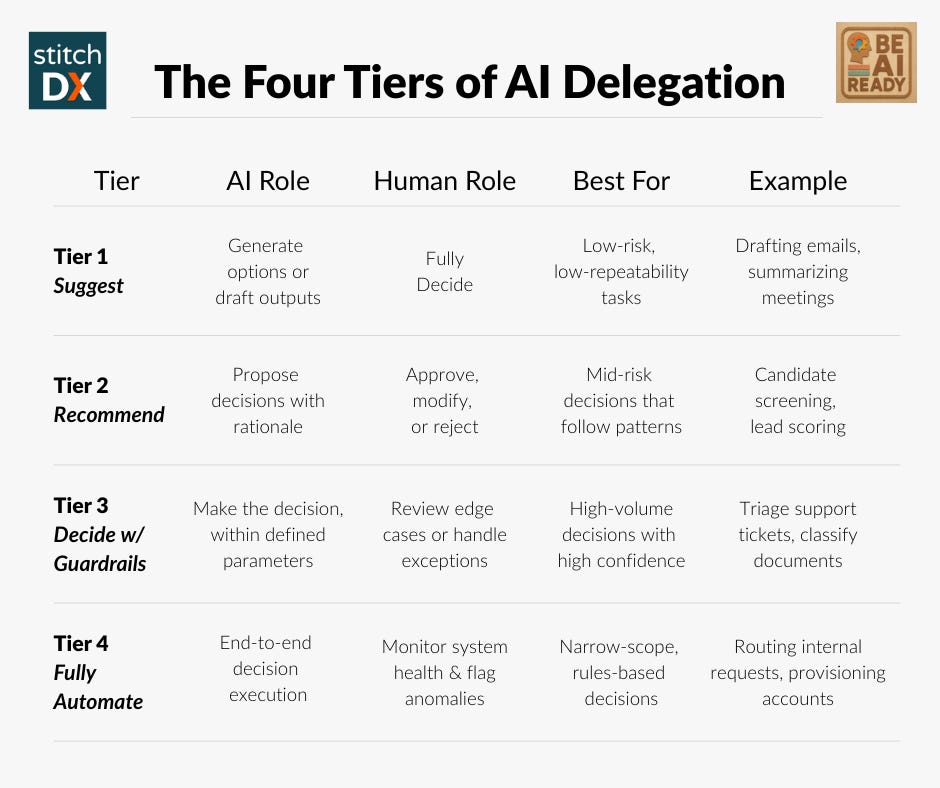3. From Decisions to Delegation: Designing Your AI-Ready Operating Model
You’ve mapped your decisions — now what? Here’s how to design smarter, AI-augmented workflows without losing control.
Mapping decisions is a powerful first step. It shows you where the friction lives, where work gets stuck, and where human judgment is slowing things down unnecessarily.
But here’s the hard truth: a map isn’t a strategy.
Organizations that stop at mapping will get insights. But the ones that win will move from insight to redesign — rethinking who (or what) makes decisions, under what conditions, and with what oversight.
This is the next evolution of your Cognitive Operating Model: not just visualizing where cognition happens, but designing how it scales.
The Shift From Mapping to Delegating
Once you’ve identified your high-friction decisions, the next step is to determine which ones can be augmented or delegated to AI — and how.
To do that effectively, you need to look at three dimensions:
Ownership – Who makes the decision? (AI? Human? Both?)
Confidence – How risky is the decision if it goes wrong?
Oversight – What level of human review, escalation, or monitoring is required?
From this, we can define four tiers of AI delegation.
The Four Tiers of AI Delegation
Once you understand the dimensions of ownership, confidence, and oversight, you can begin to assign the right level of responsibility to AI — and just as importantly, know what to hold onto.
I use this four-tier model to help organizations make those decisions with intention, not instinct. Think of it as a spectrum of delegation, from co-pilot to autonomy, governed by your risk tolerance and operational maturity.

This isn’t just a scale of automation. It’s a system of intentional delegation.
Each tier reflects how much responsibility you’re willing to hand over — and what safety nets you need in place.
Cognitive Guardrails: Where Governance Meets Velocity
Delegation without control is chaos. That’s why each tier must be paired with what I call cognitive guardrails:
What data can the AI see?
What thresholds require human review?
How are decisions logged and auditable?
How do we capture and learn from edge cases?
These aren’t blockers. They’re accelerators — because they create trust. And trust is what lets you scale AI into workflows without slowing your business down.
A Real-World Example: AI in Customer Routing
Let’s say you’ve mapped out your customer service escalation flow. You find that 70% of inbound tickets are routine, but 30% are ambiguous — and reps often over-escalate out of caution.
Here's how the delegation model might apply:
Tier 1: Suggest — AI suggests a draft reply for common issues.
Tier 2: Recommend — AI classifies tickets by urgency and topic, recommends routing.
Tier 3: Decide with Guardrails — AI routes routine tickets directly, flags uncertain ones for human review.
Tier 4: Fully Automated — Fully automated triage and routing for narrow categories (e.g. password resets).
This isn’t about replacing agents. It’s about letting agents focus where judgment is actually needed — and letting AI carry the cognitive load everywhere else.
The Payoff: Not Just Efficiency — Strategic Capacity
Delegating decisions to AI isn’t just about saving time. It’s about creating room for higher-order thinking in your teams.
Less time spent triaging, more time improving systems.
Fewer repetitive approvals, more space for strategic analysis.
Lower cognitive drain, higher creative output.
You’re not removing humans from the loop. You’re redefining where they belong in it.
Final Thought: Don’t Just Map Work — Redesign It
A decision map is a snapshot. A delegation model is a system.
If you want to operate on AI, not just integrate it, you need both.
Start by mapping decisions. Then decide: What can you delegate? What must stay human? And what rules will make that work at scale?
This is how you move from insight to execution. This is how you build your Cognitive Operating Model.
In the next post, we’ll look at where these systems often break — and how to avoid the most common failure patterns in AI orchestration.
Subscribe to stay with me — and let’s keep building smarter systems from the inside out.



